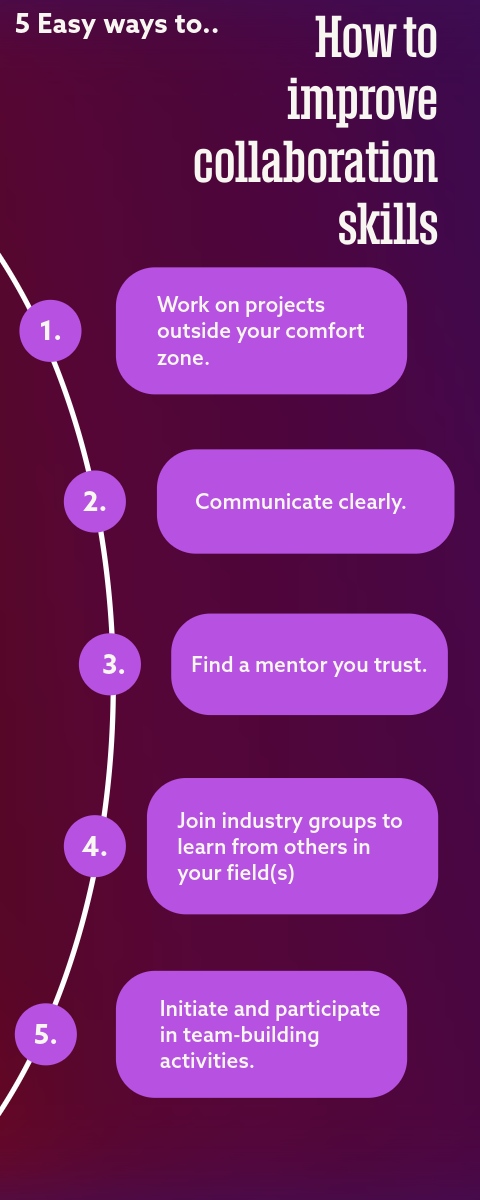How to collaborate successfully

- Mar 19, 2021 modified: Jul, 31 2025
How to collaborate successfully
Collaboration can be defined as working together with one or more people to complete a project or task; or to increase knowledge and skills; or to develop ideas; or to establish protocols and processes; or to improve or refine current products and services; or to find new markets; or to create new products and services.
In an educational setting, collaboration can enhance an individual's research, knowledge and technical skills, in addition to aiding the acquisition of soft skills such as communication, cooperation and teamwork.
In the workplace, collaboration occurs when two or more people work together towards a common goal that benefits the team or company. Efficiency is an essential part of a team and an important aspect of the workplace. Collaboration in the workplace is a sign of an effective team that harnesses the best out of two or more individuals working together.
It is often assumed that collaboration and teamwork mean the same thing; however, there are subtle differences between the two.

Teamwork
Teamwork is the joint action of people working toward the same goal and working together effectively to complete a task. An effective team supports each individual in the team, communicates well and equitably distributes the workload.
Other characteristics of an effective team include team autonomy, sharing similar skills, having defined roles and leadership and the resources to meet the team's goals.
Collaboration
On the other hand, when working collaboratively, members of a team may have different skill sets. Their diverse set of different skills allows them to problem solve as a group.
And although the team members have varying areas of expertise, they collaborate by sharing similar goals, resources and leadership.
When we talk about collaboration, we are talking about problem-solving with a group of people with different skill sets. However, what makes this collaborative group work successfully can also cause it to fail. Different skill sets often bring together people who think and communicate differently to one another and who have different priorities.
Coordination and Cooperation
Two major elements of collaboration are coordination and cooperation. Coordination guides participants as to their roles and how and when they will contribute. Coordination also helps to achieve efficiency and productivity through being organised by a leader or coordinator.
Cooperation encourages the sharing of ideas, approaches or activities and is usually an informal process indicating a healthy culture within a business or team.

Communication
Communication is another key element of working together and requires team members to talk to each other with respect. Even though these five terms have similar connotations, they differ in their level of purpose and dependence.
(from https://www.smartsheet.com/collaborative-teamwork)

What Is Good Communication?
Good communication involves conveying a point in a simple and clear manner and looking for nonverbal cues from participants through active and deep listening. Good communicators:
- Relate their message to their listener on a personal level
- Provide factual information
- Give specific information in a brief manner
- Ask questions to ensure understanding
- Ask questions for clarification
- Encourage team members to ask questions
- Listen actively
- Look for nonverbal cues
"I have to spend a little bit of time just trying to figure out, like, what kind of frame of mind you're in, are you in a practical frame of mind, or an emotional frame of mind, or social frame of mind?"
related article:
Deep Listening
Another interesting formula for lines of communication shows-:
"Essentially the more people involved in a project there becomes an exponential rise in the lines of communication involved to keep everyone informed."
Collaboration in the Workplace
The success of collaborations depends on whether team members are committed to working together, can respect each other's differences and have the required skills. Before considering a collaboration, whether internal or with other companies, a number of factors should be considered.
"Collaboration for its own sake can waste precious time and resources. You should ask why collaboration is the best answer. Then, you should ask the following questions:"
- Can you create the conditions for success?
- Is the team full of talkers or doers?
- Can you scale the project up if necessary?
- Are you collaborating with one company too frequently?
- If you are working with an external partner, are they vetting you as well?
- What are the other company's values?
- What is the expected return on investment?
- Does your proposed team have the necessary experience and skill sets?
(Becky Simon. A Winning Combination: Collaborative Teamwork Equals Teamwork and Collaboration. Aug 28, 2017)

Collaboration skills
Crucial collaboration skills include the following:
- Open-mindedness - being open to and accepting of new ideas.
- Clear and thoughtful communication
- Coordination and Organisation.
- Long-term thinking.
- Adaptability.
- Encouraging debate and discussion
Teamwork includes an ultimate authority or 'team leader' who makes decisions and resolves disputes for the team.
Collaboration may not have an ultimate authority; however, it should have a leader who understands the nature of the work and establishes ground rules with the team.
Collaboration in the Educational Setting
An educational environment allows people to try new things, make mistakes, and learn hands-on without fear.
A collaborative team approach may assist in the development of social skills, positive cultural relations, self-esteem and proficiency in self-directed learning. Students can be enticed to higher-level thinking skills through collaborative team activities that allow them to consider different points of view.
Collaboration Tools
There are a myriad of collaboration tools that can be employed as part of the collaborative process. These are just a few:
- Interactive displays.
- Trello, Google docs, Microsoft Teams & other collaborative platforms.
- Zoom and other video conferencing platforms.
- Facebook, Youtube, Instagram & other social media platforms.
- Huddle rooms with audio and video capabilities.
- Google & other search engine, web browser, email platforms.
- Team building days.

Advantages and disadvantages of online collaboration
Online collaboration was already becoming a permanent feature of the modern workplace by allowing employees to work together from anywhere and at any time.
The world Covid-19 pandemic accelerated, in fact, forced the adoption of internet-enabled devices and communication platforms by companies and educational institutions when businesses and schools were required to shut down their premises during the height of the pandemic and beyond.
Through the changes made necessary by social distancing and Covid-safe protocols, the world has discovered that there are many advantages to remote online collaboration and communication. There are also disadvantages.
1. Productivity
Pros: Online collaboration gives team members the tools they need to work with others from any location, including from home and while travelling. This drastically reduces "downtime" and allows people to be productive when it best suits them.
Cons:Personal contact is reduced, which can lead to confusion over what is expected of team members. They may also feel that being connected 24/7 is blurring the boundaries between their professional and private lives. Online collaboration also requires each team member to be responsible for their own tasks and keep each other accountable, to ensure deadlines are met.
2. Efficiency
Pros: Employees typically spend three hours a day searching for information and/or writing emails. However, when used properly, an online collaboration tool can eliminate a lot of these redundant emails. With all of the communications in one secure, online platform, it's simple for team members to login and find the information they need to do their job. This significantly reduces the time spent searching through long email exchanges, meaning more efficient communication.
Cons: An online collaboration tool generating many (if not more) emails can be counter-productive. On a daily basis, email inboxes can quickly get cluttered with the vast amount of notifications from an online collaboration tool.
3. Cost
Pros: Online collaboration is highly cost-effective compared to traditional methods, and is within reach of all sizes of organisation. Also, because collaborating online allows employees to work from home or other locations, there is potential for cutting the cost of office and business overheads such as equipment, electricity and space.
Cons: An online collaboration package needs to offer a fair pricing structure. Some packages force you to buy licences for uses you don't need. A "per user per month" pricing model may lead organisations to limit the access to selected users only. This can cause a disparity in transparency and communication across teams and within teams in the workplace.
4. Audience
Pros: The right software will allow the potential for working closer with external stakeholders, such as key clients, partners and suppliers. It's possible to engage with more external stakeholders than by using traditional methods such as meetings, phone calls, paper surveys, press advertisements etc. This allows diversity and creativity in collaborations and the development of stronger relationships.
Cons: It may be tempting to widen the number of people you engage in collaborations without properly assessing the reasons why you need to engage with them. This can lead to a diffusion of focus and a slowing down of the collaborative process.
5. Security
Pros: The most trusted online collaboration platforms have many safeguards in place to protect their users' data. By having encryptions, password protection, two-step authentication and firewalls, users can have peace of mind knowing their sensitive data is secure and safe.
Cons: Online collaboration typically functions on a cloud-based workspace, so securing the safety of information is vital. There are business managers who still believe that storing data in the cloud is not as secure as keeping it on their personal servers, despite the improvements and progress that have been made in ‘cloud' security.
6. Project Management
Pros: One of the major advantages of online workspaces is they ensure all project materials and communications with external parties are kept within the same workspace. A full audit trail of every person's interaction with the workspace combined with team calendars and task lists, any size project with users across multiple organisations becomes more simple, quicker and cost-effective to manage.
Cons: A project is only as good as the way it is managed. It is important to coordinate and organise processes and desired timelines before inviting colleagues to join a workspace and to appoint effective managers or team leaders to oversee progress.
(Adapted from https://www.kahootz.com/advantages-and-disadvantages-of-online-collaboration/)
How to improve collaboration skills
Know yourself and how you communicate. Come into the team with an understanding of your skills, strengths and weaknesses.,
1. Work on projects outside your comfort zone.
2. Communicate clearly.
3. Find a mentor you trust.
4. Join industry groups to learn from others in your field(s)
5. Initiate and participate in team-building activities.

How to create workplace collaboration skills
Know your team and how they communicate. Come into the project with a sense of what each person has to offer.
- Be realistic about timing.
- Make room for mistakes and praise.
- Keep in touch with participants in the collaboration.
8 Steps to setting up a Collaborative Environment
The following steps can assist in the setting up of teams towards successful outcomes through collaborations.
Step 1: Identify individuals' strengths.
Step 2: Establish realistic expectations and clarify goals.
Step 3: Identify the collaboration tools to be used.
Step 4: Encourage open-mindedness.
Step 5: Reward innovation.
Step 6: Celebrate the team's success publicly.
Step 7: Support a strong sense of community.
Step 8: Spread and delegate tasks.
To collaborate successfully,
"A collaborative group leader leads the group's process, not the group itself... This strategy is more about facilitating the group effort than about making decisions for the group."
AI to amplify collaboration
AI as a form of collaboration isn't about replacing human creativity - it's about amplifying it. Whether you're brainstorming ideas, solving technical challenges, or crafting compelling content, AI can act as a thought partner that accelerates discovery and execution. The magic happens when human insight and machine intelligence work together - not in competition, but in synergy.
Search News Articles...
Recent Articles

Most AI Websites Fail to Rank
- Nov 18 2025
- /
- 230

Sitemap.xml Best Practices
- Oct 14 2025
- /
- 650

Fake Reviews on Google My Business
- Oct 07 2025
- /
- 442

Sending Emails from Code
- Sep 17 2025
- /
- 541

US Tariff Shifts Undermining eCommerce
- Sep 05 2025
- /
- 667

Small Business Success Formula
- Aug 23 2025
- /
- 516

Do Strong CTAs Help or Hurt Your Website?
- Jul 31 2025
- /
- 712

AI Crawlers vs Search Crawlers
- Jul 04 2025
- /
- 871

AI vs. Human Writing - How to detect Ai
- Jun 26 2025
- /
- 1273

Optimising for Brand SEO
- May 12 2025
- /
- 918
View All News Articles
Categories
A Gold Coast SEO and Web Developer